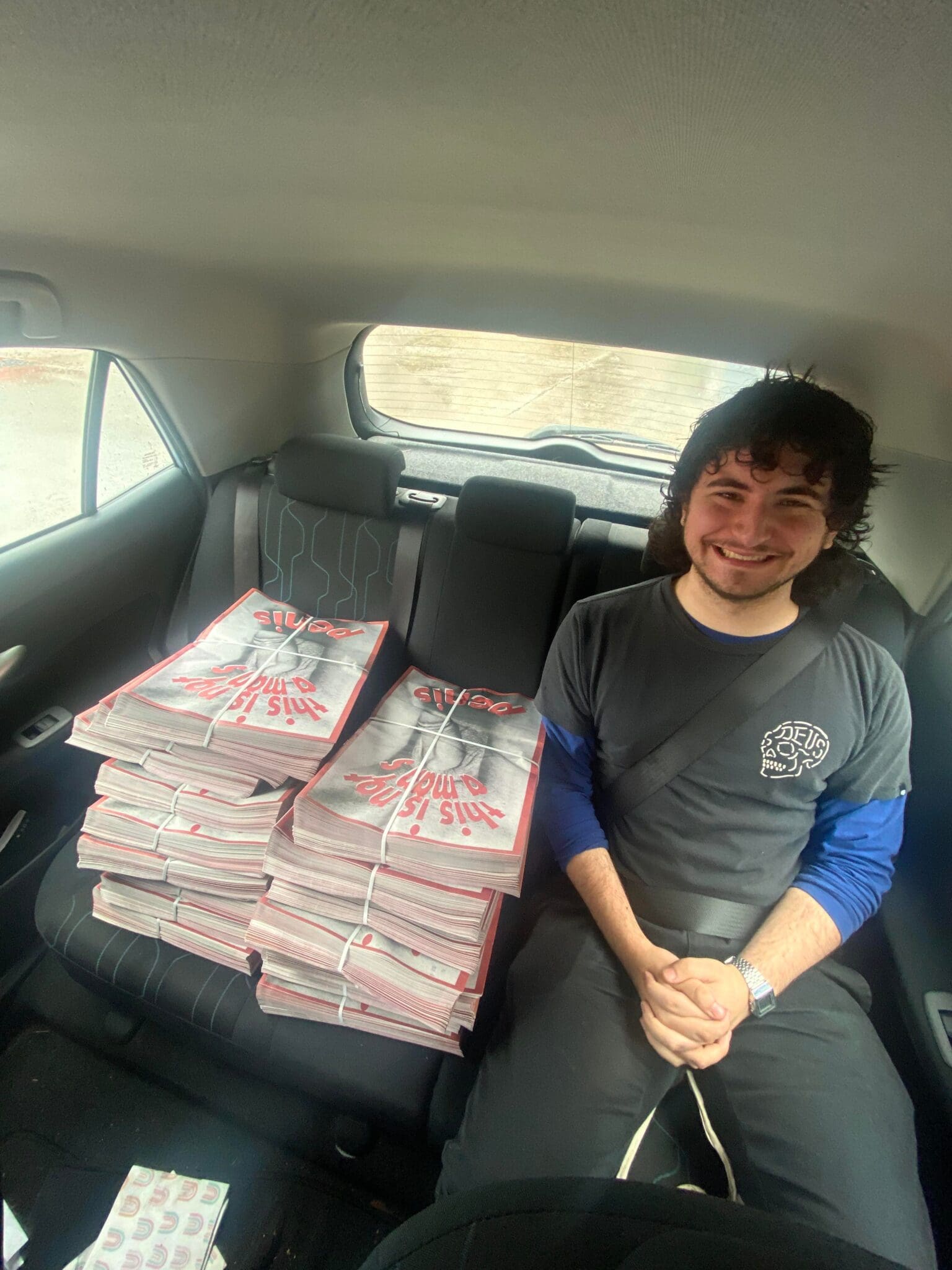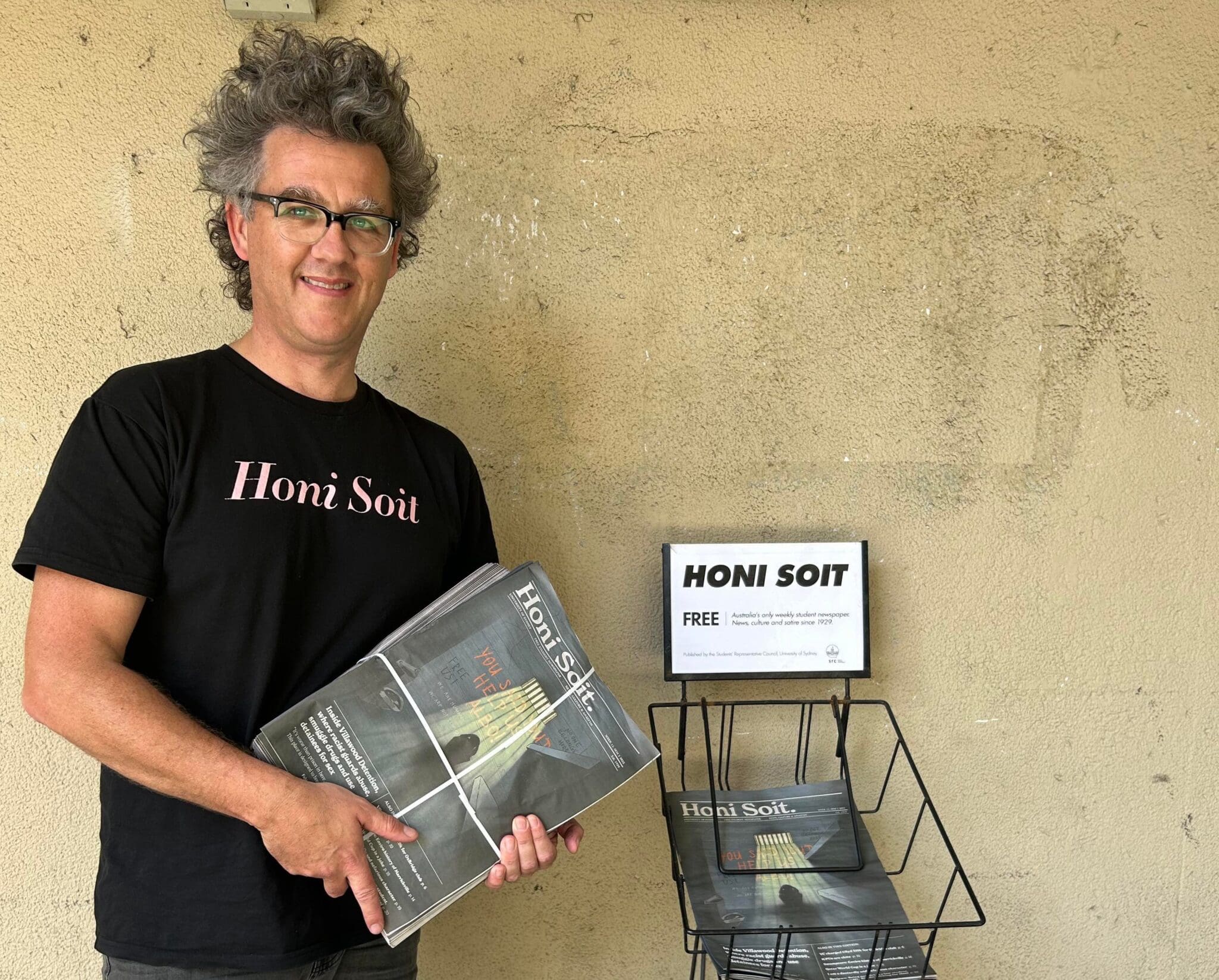Most Tuesday afternoons, a new batch of Honi Soit appears on stands across campus. Fresh stacks of 50 get swapped out for whatever remains of the previous week’s edition. The collation and printing of a weekly newspaper, for students and by students, has been going on at the University of Sydney for nearly a century, although it’s changed a lot over that period. So what’s going on behind the scenes?
The basic production of the newspaper is fairly straightforward — the editors seek pitches from students, edit them, and lay them up in a digital spread. This infamously involves a gruelling several-hour layup that goes late into each Sunday night (or Monday morning).
After that, the paper must be checked by the SRC’s Directors of Student Publications and President. As the SRC is the publisher of Honi, they have a stake in ensuring we don’t publish anything legally problematic, so they check for issues like potential defamation.
On Monday afternoon, the paper gets sent to the printers — a commercial printing press located in a large warehouse in Marrickville. SRC Publications Manager and total legend, Mickie Quick, picks it up and delivers it to the stands across campus in a route perfected over several years of deliveries. Mickie also heroically detects every InDesign fuck-up — missing links, overset text, things that might not print right — he’ll catch them.
I spoke to Mickie about the process, and what he wishes more students knew about Honi’s production.
A rich history
Having been the Publications Manager for almost nine years, Mickie is a rich source of information about Honi. I asked him if he had a favourite edition of the paper from his time working with it.
He said that the 2016 joke edition — an uncannily accurate satire copy of The Australian — stood out: “I would’ve called myself a Culture Jammer back in the ‘90s when I was doing that kind of culture jamming. But to see it done on that sort of scale, where it’s in newsprint, it’s the same size as The Australian …Brilliant!”
“I got quite personally involved too, because our current printer refused to release it. After they printed it, one of the managers found it and just said, ‘what the hell! We don’t print for The Australian’, and then just got very confused, and then realised it was us and wouldn’t release it.
“So I busted a gut to find another printer to make it happen, which wasn’t easy but was really fun, I just loved it.”
Mickie says the paper is a rich source of history on campus life. Bound editions of the Honi editions from each year can be found in Mickie’s office. He says: “For some reason, there’s a tradition that they’re bound in red cloth. But there’s one volume in blue cloth which is 1979… the year that Tony Abbott was President [of the SRC]. It sticks out like dog’s balls on my shelf, this blue version.”
“I don’t quite know if he ordered that… it raises more questions than it answers: who ordered the blue? Was it him?”
Mickie says the blue version contains telling lessons on Abbott’s character: “You open it up and you realise what a wrecker Tony Abbott was. He took control of the SRC in order to destroy it. If you read his President’s reports, they’re just unbelievable.”
This campus history is tangible and visceral: “I love seeing the actual newspaper too. The yellowed, old, tattered copies that we have in our not-very-great archive,” Mickie says. “The ongoing nature of the paper means you look back into this one source on what are these bits and pieces that happened in the history of student activity on campus.”
The paper has changed over time, however. Mickie notes that, “in my time it’s possibly been way more professional… In the ‘90s it might have felt a bit more underground, and way more so in the ‘60s and ‘70s.”
“I like that you can have wild and cutting-edge satire and content, and a kind of professionalism as well, that you see in the most recent times. But I do also really love the very DIY sensibility in earlier times.”
Print media? Not old news!
Despite much anxiety about the death of print media, Mickie feels Honi and community media more broadly is still going strong.
“When we went into lockdown a lot of the local community newspapers around the country were shutting down because they were all syndicated and the big syndicate owners were just cutting them. I was worried the printer would go out of business so I had a chat with someone quite high-up there,” Mickie recalls.
“I asked them how it was going and they said, for every community newspaper that’s shut down, local communities just started up their own. He said it was thriving, and it was just this really nice thing that feels like you can’t believe it still exists, and I do get that from ex-USyd students if I’m wearing an Honi t-shirt or they see me distributing it. They say ‘oh my god, does that still exist’.
“There’s just this sort of expectation that surely it’s going to die soon, but actually, community newspapers are thriving, and so is Honi.”
Mickie feels like the weekly element of the paper is essential: “Too often student media elsewhere is, at best, a monthly, lifestyle-like magazine, but being weekly Honi gets to actually be topical, right down to the week.”
In his job as Honi distributor, he sees how students interact with it and seek it out.
“Pretty much every week, at least a few people stop in their tracks and wait for me to actually take the plastic binds off it so I can put it in the stands. I can tell they want a copy so I grab one off the top and give it to them personally,” he told me.
Mickie said interest in the physical paper is pretty hard to predict from stand to stand: “It surprises me, like I’ve got this ongoing sense of what I think each stand will take, and then some I’ll go ‘oh, there’s not so much of a take up on this stand, I’ll do less’. Then I’ll come back the next week and it’s completely gone.”
“But there’s maybe three or four locations where sometimes I could just leave a pallet load there and I wonder if they’d all go. One of those is the Holme Building, I could put six bundles and they might all go. Fisher is pretty big and Jane Foss Russell. I guess they’re each a kind of thoroughfare through the campus, a lot of people are picking it up that way.”
Mickie also saw the project of mailing out Honi during lockdown last year as indicative of ongoing interest in the physical newspaper.
“You never know whether people are picking it up out of the stands just out of habit and not actually reading it. But when people specifically type in their address and request one, it’s like, oh they really want it. The form online would have commentary about how much they missed the paper as part of campus culture. It was a great pivot,” he said.
“It was just really heart-warming. I love any moment that you can tell the paper is really appreciated. Sometimes you wonder, is it an anachronistic project, is it out of date producing a printed publication when you could just put stuff online? But projects like that just revealed how much people loved getting a thing that they could just open up and flick through from page to page, and it’s weekly.”
The joy of playing at adulthood
The project of putting 300 to 400 editions in envelopes, stamping them and sending them out involved a lot of work, which Mickie managed with the assistance of a junior helper:
“I would engage the help of my 10-year-old kid, actually, to run from the car to a letterbox. I worked out that with the ones all really close to campus, it wasn’t as efficient to put postage stamps on those. A street like Australia Street in Newtown would have about seven different addresses along it. I paid my 10-year-old 50 cents an envelope to run out and deliver them, and it was his form of lockdown exercise and income.”
Asked whether his 10-year-old was interested in Honi, Mickie said: “They love the sense of what might seem to a 10-year-old as a novel playing-at-adults kind of game, of making your own newspaper. But it’s real, and it keeps going and it’s there every week!”
“It totally reminds me that as a kid I did that, but I didn’t have access to a photocopier so I had to go up to this newsagent where I would hand it over the counter for them to do the copying. And I was just taking bits of news — I was basically just regarbling bits of existing news, but making it into my own newspaper.”
Editors try distribution
Typing away maniacally in the Honi office, I do very much feel like I’m playing at being a real journalist sometimes — it’s a pretty fun game!
But a few weeks ago, two of my fellow editors and I swapped places with Mickie, taking on the distribution while he had a week off. There were a few pitfalls — the papers didn’t quite fit in the compact boot of my Corolla; we forgot the trolley used to roll Honi around, so we had to carry them; and, crucially, it was absolutely pouring rain.

We sprinted around campus bearing stacks of 200 or so newspapers, attempting to follow the path of maximum efficiency indicated to us by Mickie on a custom Google Map. I parked sheepishly in loading zones, a handwritten ‘SRC business’ sign surprisingly successful in warding off parking tickets.
I experienced a marginal increase in bicep strength and, given it was Queer Honi, a test of spiritual strength as I lugged an A3 dick around campus, enduring a deluge of quizzical looks to rival the meteorological downpour.
Nevertheless, seeing the pallet of newly printed Honis in the flesh, holding its weight in my arms, I was inclined to feel very similarly to Mickie about the indelible delight of the printed edition.





